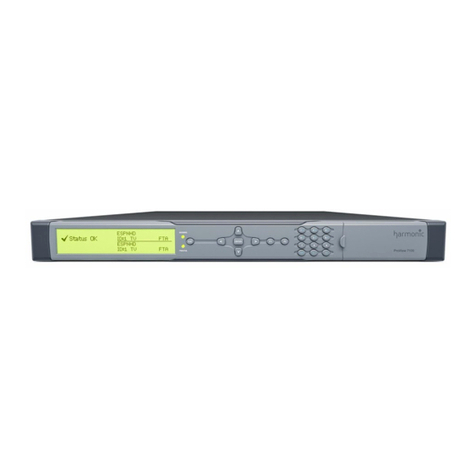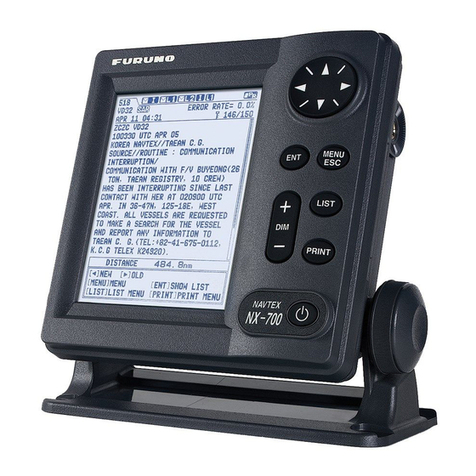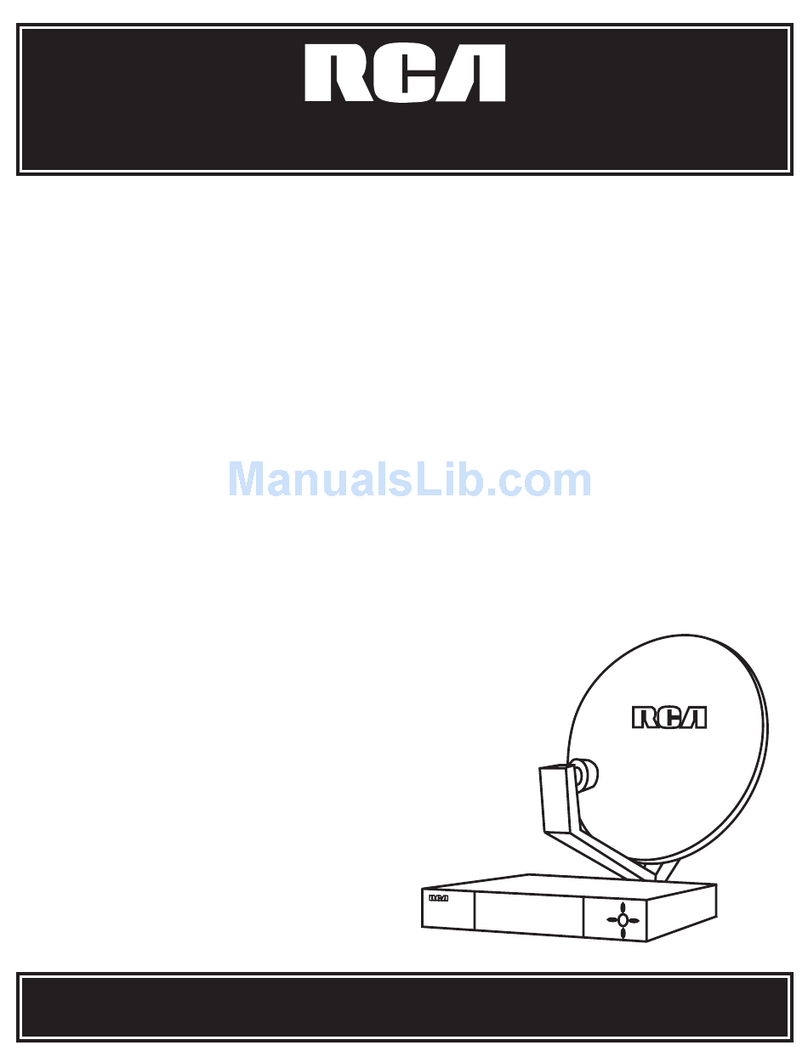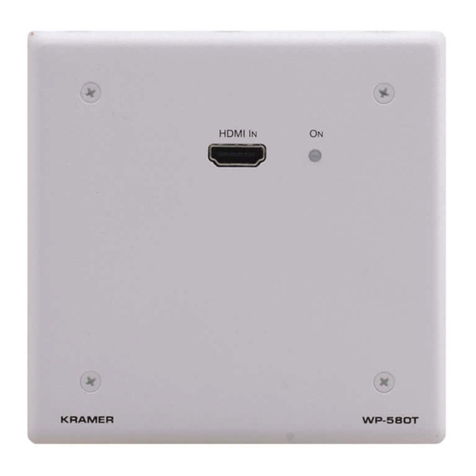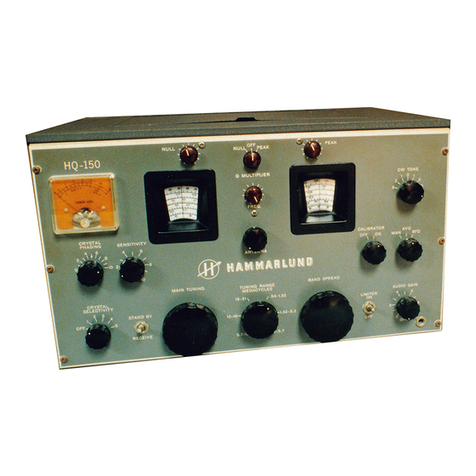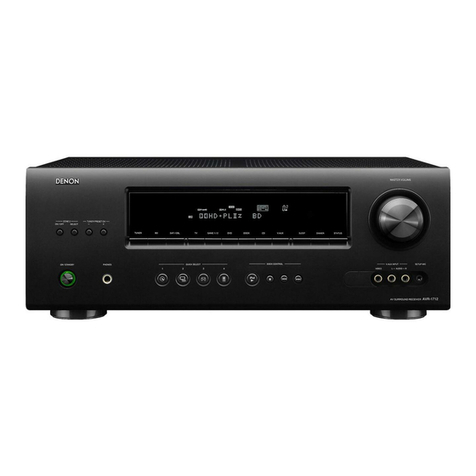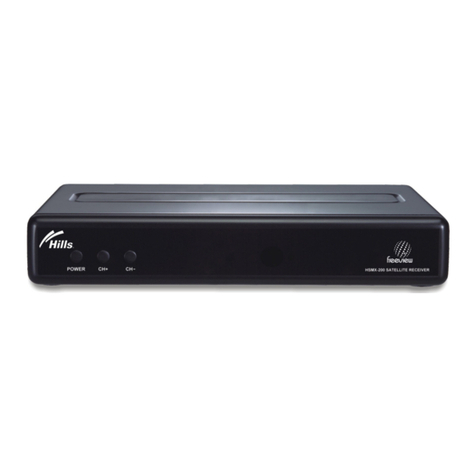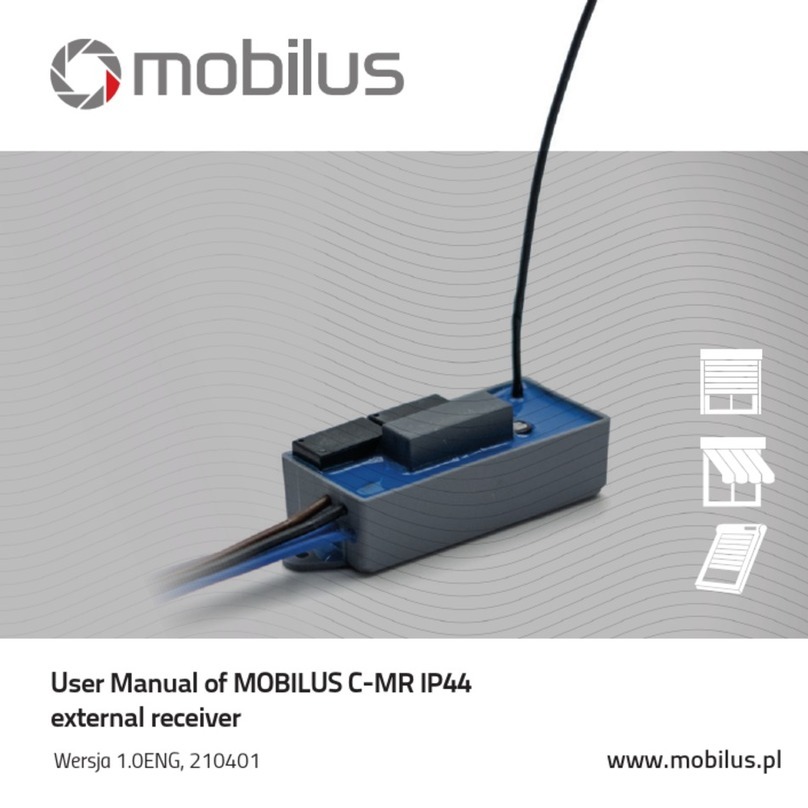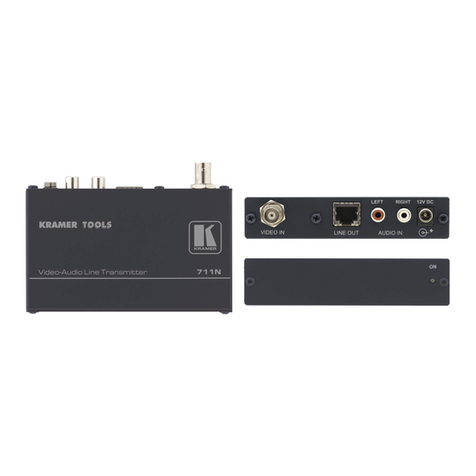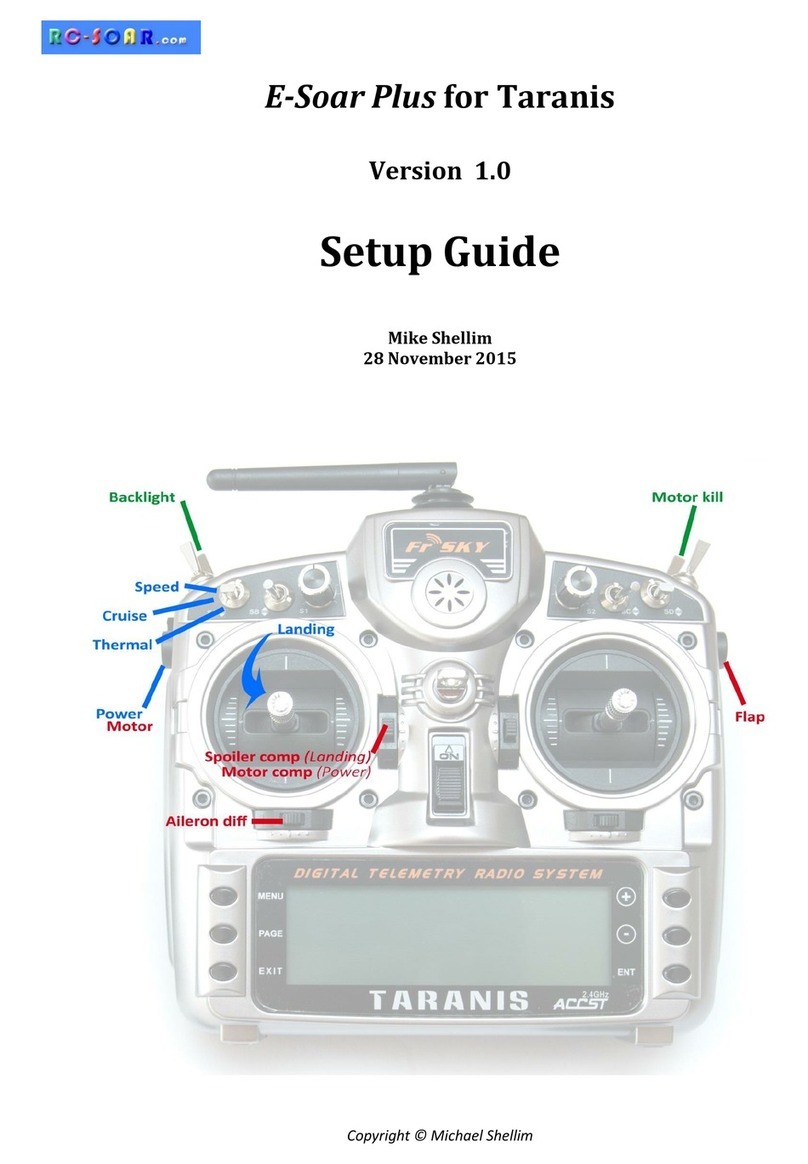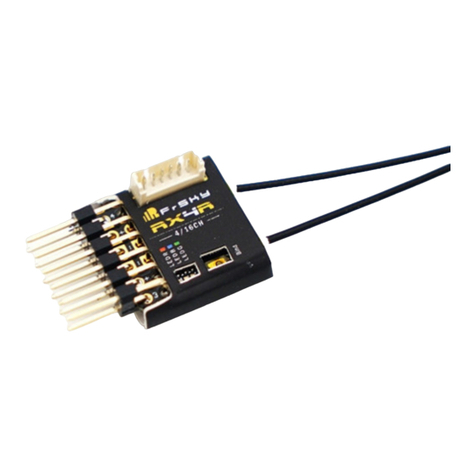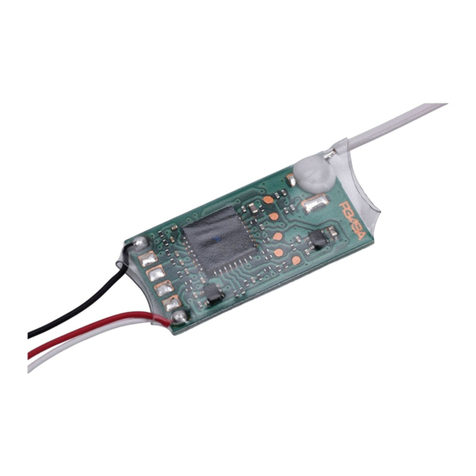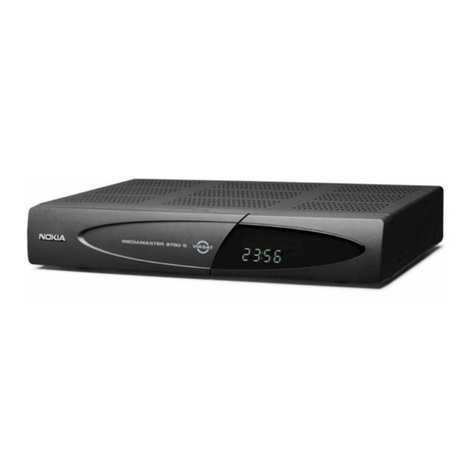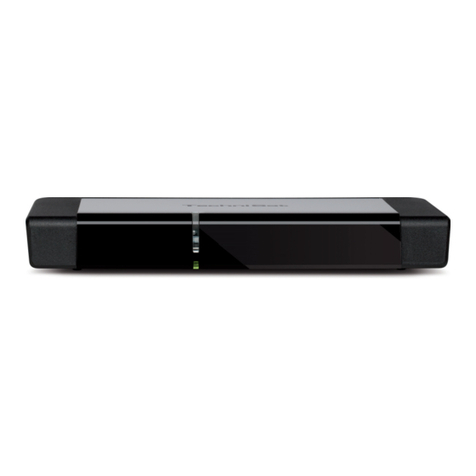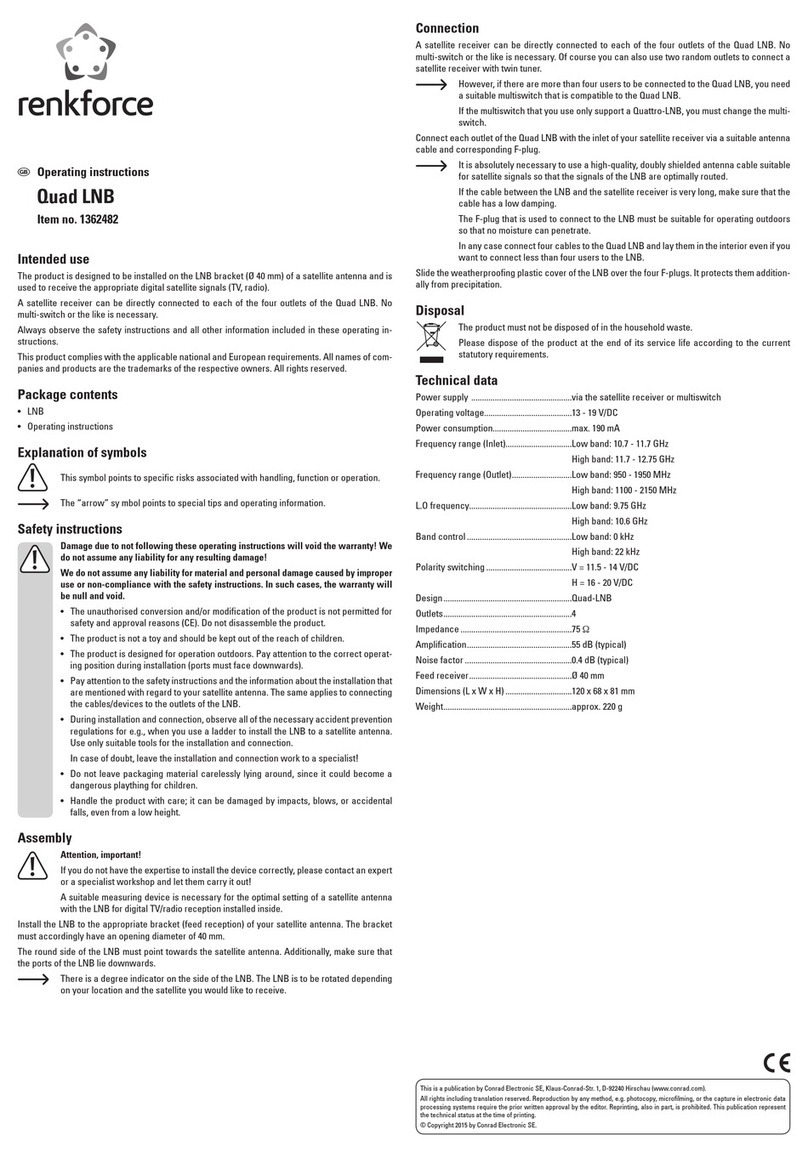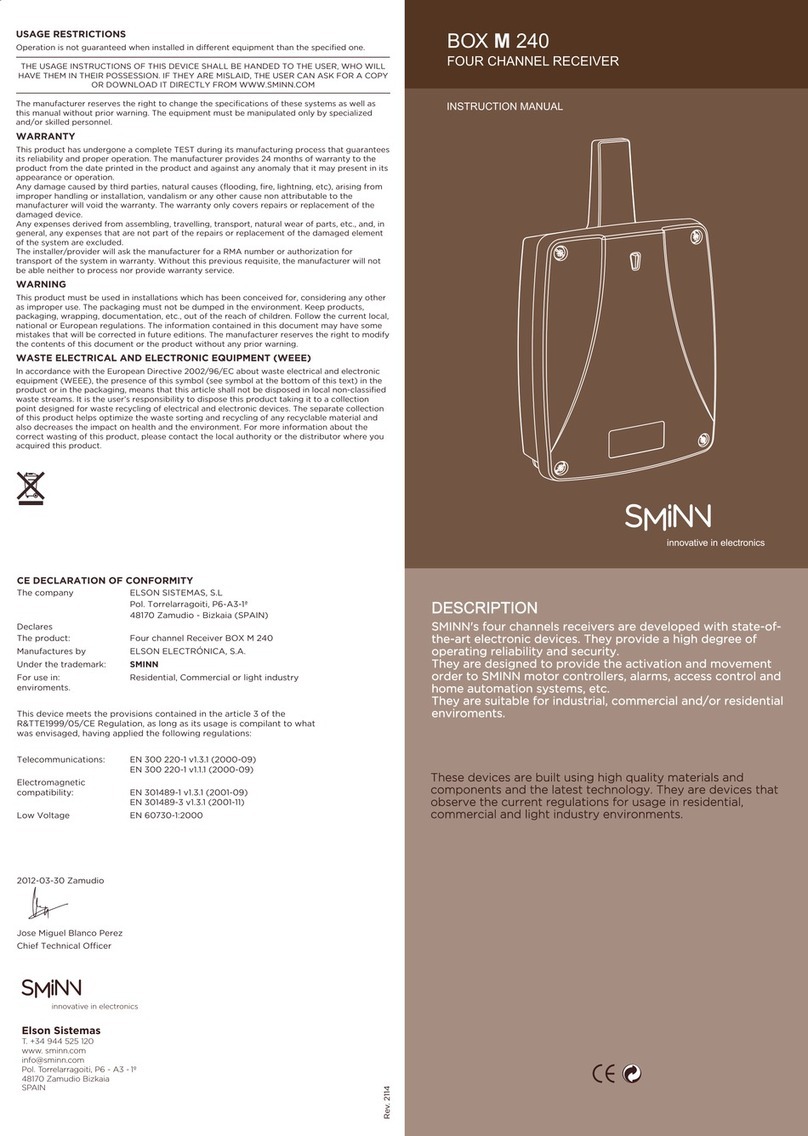Harmonic HRR 4104 User manual

HRR 4104
Return Path Receiver
Product Manual
Manual Part No.: 700-0051981
Rev A
March 2005

HRR 4104 Return Path Receiver Product Manual
Copyright © 2005 Harmonic Inc.
Copyright 2005 Harmonic Inc
.
Harmonic continues to improve and enhance all product designs. Specifications are subject to change without notice. Harmonic and logo design,
eXchange, MAXLink, METROLink, NETWatch, PWRBlazer, TRANsend, and “Redefining the Network” are trademarks of Harmonic Inc. YAGLink
and PWRLink are registered trademarks of Harmonic Inc. All other names are trademarks or registered trademarks of their respective owners.

HRR 4104 Return Path Receiver Product Manual Rev A (3/05) iii
Table of Contents
Chapter 1 Overview
1.1 About This Manual . . . . . . . . . . . . . . . . . . . . . . . . . . . . . . . . . . . . . . . . . . . . . . 1-1
1.2 Description . . . . . . . . . . . . . . . . . . . . . . . . . . . . . . . . . . . . . . . . . . . . . . . . . . . . . 1-1
1.3 Applications . . . . . . . . . . . . . . . . . . . . . . . . . . . . . . . . . . . . . . . . . . . . . . . . . . . . 1-3
Chapter 2 Installing the HRR 4104 Receiver
2.1 Receiving and Inspecting . . . . . . . . . . . . . . . . . . . . . . . . . . . . . . . . . . . . . . . . . 2-1
2.2 Tools and Accessories . . . . . . . . . . . . . . . . . . . . . . . . . . . . . . . . . . . . . . . . . . . . 2-1
2.3 Installing the HRR 4104. . . . . . . . . . . . . . . . . . . . . . . . . . . . . . . . . . . . . . . . . . . 2-2
2.4 Configuring Two HRR 4104 Modules as a Redundant Pair . . . . . . . . . . . . 2-4
2.5 Connecting the RF Output Cables . . . . . . . . . . . . . . . . . . . . . . . . . . . . . . . . . . 2-5
2.6 Installing and Using the HFM 4000 Fiber Management Tray . . . . . . . . . . . 2-5
2.7 Connecting the Input Fiber Cables . . . . . . . . . . . . . . . . . . . . . . . . . . . . . . . . . 2-7
2.8 Testing RF Signal Output . . . . . . . . . . . . . . . . . . . . . . . . . . . . . . . . . . . . . . . . . 2-8
Chapter 3 User Interface Options
3.1 HLP 4200WD Display . . . . . . . . . . . . . . . . . . . . . . . . . . . . . . . . . . . . . . . . . . . . 3-1
3.1.1 Main Menu . . . . . . . . . . . . . . . . . . . . . . . . . . . . . . . . . . . . . . . . . . . . . . . 3-1
3.1.2 Receiver Menu . . . . . . . . . . . . . . . . . . . . . . . . . . . . . . . . . . . . . . . . . . . . 3-3
3.1.3 Receiver A, B, C, D Menus . . . . . . . . . . . . . . . . . . . . . . . . . . . . . . . . . . 3-4
3.1.4 Module Menu . . . . . . . . . . . . . . . . . . . . . . . . . . . . . . . . . . . . . . . . . . . . . 3-6
3.2 NETWatch Site Controller. . . . . . . . . . . . . . . . . . . . . . . . . . . . . . . . . . . . . . . . . 3-7
3.3 HRR 4104 Front Panel LED Indicators . . . . . . . . . . . . . . . . . . . . . . . . . . . . . . 3-7
3.4 HRR 4104 Alarms . . . . . . . . . . . . . . . . . . . . . . . . . . . . . . . . . . . . . . . . . . . . . . . . 3-8
Chapter 4 Setting Up the HRR 4104 Receiver
4.1 Adjustment Options. . . . . . . . . . . . . . . . . . . . . . . . . . . . . . . . . . . . . . . . . . . . . . 4-1
4.1.1 Optical Alarm Limit . . . . . . . . . . . . . . . . . . . . . . . . . . . . . . . . . . . . . . . 4-1
4.1.2 Input Wavelength 1550/1310 nm . . . . . . . . . . . . . . . . . . . . . . . . . . . . 4-1
4.1.3 Mute . . . . . . . . . . . . . . . . . . . . . . . . . . . . . . . . . . . . . . . . . . . . . . . . . . . . 4-2
4.1.4 AGC Mode . . . . . . . . . . . . . . . . . . . . . . . . . . . . . . . . . . . . . . . . . . . . . . . 4-2
4.1.5 AGC Pad Setpoint . . . . . . . . . . . . . . . . . . . . . . . . . . . . . . . . . . . . . . . . . 4-2
4.1.6 AGC Optical Setpoint . . . . . . . . . . . . . . . . . . . . . . . . . . . . . . . . . . . . . . 4-2
4.1.7 AGC Pad Maximum/Minimum . . . . . . . . . . . . . . . . . . . . . . . . . . . . . 4-2
4.1.8 Manual RF Pad Value . . . . . . . . . . . . . . . . . . . . . . . . . . . . . . . . . . . . . . 4-3
4.1.9 Default Adjustment Values . . . . . . . . . . . . . . . . . . . . . . . . . . . . . . . . . 4-3
4.2 Understanding the AGC Function. . . . . . . . . . . . . . . . . . . . . . . . . . . . . . . . . . 4-3
4.3 Setup via HLP 4200WD Display . . . . . . . . . . . . . . . . . . . . . . . . . . . . . . . . . . . 4-4
4.4 Setup via NETWatch Site Controller. . . . . . . . . . . . . . . . . . . . . . . . . . . . . . . . 4-6

Table of Contents
iv Copyright © 2005 Harmonic Inc.
Chapter 5 Maintenance and Troubleshooting
5.1 Cleaning Fiber Optic Connectors. . . . . . . . . . . . . . . . . . . . . . . . . . . . . . . . . . . 5-1
5.1.1 Cleaning Patch Cord or Pigtail Fiber Optical Connectors . . . . . . . . 5-2
5.1.2 Cleaning HRR 4104 Optical Connectors . . . . . . . . . . . . . . . . . . . . . . 5-2
5.2 Troubleshooting . . . . . . . . . . . . . . . . . . . . . . . . . . . . . . . . . . . . . . . . . . . . . . . . . 5-2
5.3 In Case of Problems . . . . . . . . . . . . . . . . . . . . . . . . . . . . . . . . . . . . . . . . . . . . . . 5-4
5.4 Disclaimer . . . . . . . . . . . . . . . . . . . . . . . . . . . . . . . . . . . . . . . . . . . . . . . . . . . . . . 5-4
5.5 Warranty Summary . . . . . . . . . . . . . . . . . . . . . . . . . . . . . . . . . . . . . . . . . . . . . . 5-4
5.6 Limitations of Warranty . . . . . . . . . . . . . . . . . . . . . . . . . . . . . . . . . . . . . . . . . . 5-5
5.7 Exclusive Remedies . . . . . . . . . . . . . . . . . . . . . . . . . . . . . . . . . . . . . . . . . . . . . . 5-5
Appendix A Technical Specifications
Appendix B Harmonic Inc. – Offices

HRR 4104 Return Path Receiver Product Manual Rev A (3/05) 1–1
1
Overview
1.1 About This Manual
This instruction manual is a guide to installing and operating the HRR 4104
Return Path Receiver. Please read the entire manual before beginning
installation.
• Chapter 1 gives general information about the HRR 4104.
• Chapter 2 describes the installation procedures.
• Chapter 3 describes the user interfaces that monitor and control receiver
operation.
• Chapter 4 describes how to set up the receiver.
• Chapter 5 describes maintenance and what to do in the event of problems.
• Appendix A provides complete technical specifications.
• Appendix B provides a list of Harmonic’s offices around the world.
1.2 Description
The HRR 4104 is a high-performance optical return path receiver that is
optimized to operate in the 5 to 100 MHz return band. This compact (half-slot)
plug-in module is designed for use in the Harmonic HLP 4200 equipment
platform. An HMC 4008 module carrier is needed and mounts two HRR 4104
modules in the platform.
The HRR 4104 is a quad receiver card. The four receivers are designed to
operate independently, or can be configured as four redundant pairs with
another HRR 4104 module.
The HRR 4104 has the following key features:
• Very high packing density
• High RF output level
• Many configuration options
• Automatic or manual gain control to compensate for variations in optical
input
• Local control of operating parameters—provided by the HLP 4200
Platform
• Remote control and monitoring—provided by the NET 5200 NETWatch™
Site Controller

Overview
1–2 Copyright © 2005 Harmonic Inc.
Figure 1-1 shows a block diagram of the HRR 4104, including the HMC 4008
module carrier and the interface to the HLP 4200. Figure 1-2 shows front and
rear panel features of the HRR 4104.
Figure 1-1. HRR 4104 block diagram
Figure 1-2. HRR 4104 front and rear panel features
(Factory use only)
Status LED
Select LED
RF Monitor Selector Switch
Interface to
HMC 4008
RF Output Connectors
(blind mate) to HMC 4008
module carrier
Optical Input
Connectors
Lever
Front Panel Rear Panel

Applications
HRR 4104 Return Path Receiver Product Manual Rev A (3/05) 1–3
The HRR 4104 receiver is a compact plug-in module that mounts easily in
Harmonic’s HLP 4200 Platform. See Figure 1-3 for a functional diagram of the
HLP 4200 Platform and the rear panel connectors. The receiver module draws
power from the platform’s 24 VDC power bus, and communicates with the
platform controller via the platform communication bus.
For additional information on the HLP 4200 Platform and its associated
communication and power buses, see the
HLP 4200 Platform Product Manual.
For further information on the platform controller and power supply options,
see the
CPS 4200/4248 Controller/Power Supply Product Manual.
Figure 1-3. HLP 4200 functional diagram
1.3 Applications
Typical applications of the HRR 4104 include:
• Internet access
• Telephony
• Video-on-demand
• Network management
• Pay-per-view
• Data services
• Local origination
• I-net

Overview
1–4 Copyright © 2005 Harmonic Inc.

HRR 4104 Return Path Receiver Product Manual Rev A (3/05) 2–1
2
Installing the HRR 4104 Receiver
This chapter provides information on installing the HRR 4104 Return Path
Receiver. Please read all the instructions before beginning installation.
This chapter describes:
• How to receive and inspect the HRR 4104
• Tools and accessories
• How to install the HRR 4104 module into an HLP 4200 Platform
• How to configure two HRR 4104 modules as a redundant pair
• How to connect the RF output cables
• How to install and use the HFM 4000 Fiber Management Tray (optional)
• How to connect the input fiber cables
• How to test RF signal output
2.1 Receiving and Inspecting
As you unpack your unit, inspect the shipping container and equipment
for damage. Save the shipping material for future use. If the container or
the equipment is damaged, notify both the freight carrier and Harmonic.
See Appendix B,
Harmonic Inc. – Offices
, for contact information.
CAUTION:
To protect yourself from potential injury and to protect the
equipment from further damage, do not perform any
operational tests if the equipment appears to be damaged.
2.2 Tools and Accessories
The following accessories are provided with each HRR 4104:
• Antistatic bag
The following accessories are provided with each HMC 4008:
• 6-pin muting cable assembly (part no. 229-0020316)—for primary/backup
connection

Installing the HRR 4104 Receiver
2–2 Copyright © 2005 Harmonic Inc.
The following optional accessories are not included:
• Four 4 dB couplers—to combine the RF outputs from two HRR 4104
modules in a redundant configuration
• HFM 4000 Fiber Management Tray (see Section 2.6)
• Four #10 screws with 10-24 UNC thread, and Phillips screwdriver—
to mount the HFM 4000 in the rack
2.3 Installing the HRR 4104
The HRR 4104 receiver module plugs into an HMC 4008 module carrier,
shown in Figure 2-1. Each HMC 4008 carrier can accommodate two half-slot
HRR 4104 modules. The receiver module is held in the carrier by blind mate
RF connectors on the carrier. You can place the HMC 4008 carrier into any
available position in the HLP 4200 Platform.
Figure 2-1. HMC 4008 module carrier, front and rear panel features
To provide leverage for the blind mate connections, install the HMC 4008
carrier into the HLP 4200 Platform before you install the HRR 4104 module
into the carrier. The HLP 4200 Platform can be powered and operating during
the installation process.
Carrier Locking Screw
Interfaces to two
HRR 4104 modules
RF Output Connectors
RF Connectors (blind
mate) from HRR 4104
Interface to
HLP 4200 Platform
Primary/Backup Connectors
to join two HRR 4104
modules via muting cable
Front Panel Rear Panel

Installing the HRR 4104
HRR 4104 Return Path Receiver Product Manual Rev A (3/05) 2–3
To install the HMC 4008 carrier into the HLP 4200 Platform:
1. Lower the control/display panel on the HLP 4200 Platform.
2. Slide the HMC 4008 module carrier into any available slot until it is
properly seated.
3. Lock the carrier into position with the carrier locking screw, shown in
Figure 2-1 on page 2-2.
To install the HRR 4104 receiver module into the HMC 4008 carrier:
• Insert the receiver module into the carrier until it locks in position. This
requires some force as there are four blind mate connectors in the rear of
the unit.
The HRR 4104 receives power from the HMC 4008 module carrier. The carrier
is powered by the +24 VDC bus of the HLP 4200.
For additional information on the HLP 4200 Platform and its associated
communication and power buses, see the
HLP 4200 Platform Product Manual
.
For further information on the platform controller and power supply options,
see the
CPS 4200/4248 Controller/Power Supply Product Manual.
To remove the HRR 4104 receiver module from the HMC 4008 carrier:
1. Press
Eject
on the HRR 4104 module, as shown in Figure 2-2. The lever
raises approximately 10 degrees, as shown.
2. Insert your finger under the tab at the bottom of the lever, then lift up on
the lever. This disengages the blind mate RF connectors from the HMC
4008 carrier.
3. Remove the module from the carrier.
Figure 2-2. HRR 4104 side view with lever open
Lever
Eject (press here)
Tab (lift up here)

Installing the HRR 4104 Receiver
2–4 Copyright © 2005 Harmonic Inc.
2.4 Configuring Two HRR 4104 Modules as a
Redundant Pair
Each HRR 4104 module can be configured in one of the following ways:
• As an independent, standalone module (not connected to another
module)
• As the primary module in a redundant pair (connected to a backup
module)
• As the backup module in a redundant pair (connected to a primary
module)
This section provides instructions for configuring the HRR 4104 modules
as redundant pairs. If you are configuring the HRR 4104 to operate as an
independent module, you can skip this section.
Regardless of configuration, all four receivers in a module function in the
same role; all four receivers are standalone, primary, or backup. However, at
any given time, some receivers in a module can be muted (inactive) while
others are not.
In a redundant pair configuration, you use one module for primary fiber
paths and a second module for backup fiber paths. Normally, the primary
receiver mutes the RF output of the backup receiver. If the primary receiver is
in alarm (the optical input level on the primary receiver falls below a set
threshold: the optical alarm limit), the primary receiver activates (unmutes)
the backup receiver and mutes itself (unless the backup receiver’s optical
input level is also low, in which case the backup receiver remains muted).
When the primary receiver’s optical input level rises above the optical alarm
limit, it removes the
unmute
command from the backup receiver and the
backup receiver returns to its default muted state.
When configuring a redundant pair, Harmonic recommends locating the two
HRR 4104 modules in two different HLP 4200 Platforms, if possible. That way,
transmission continues even if there is problem with a platform or power
supply.
Use the muting cable (included with the HMC 4008 carrier) to connect the
two modules of the redundant pair. One end of the muting cable is labeled
Primary, the other end is labeled Backup. Use four 4 dB couplers to combine
the RF output from the two modules.
To configure two HRR 4104 modules as a redundant pair:
1. Verify that both primary and backup HRR 4104 modules are properly
mounted into one or two HLP 4200 Platforms, as described in Section 2.3.
2. Connect the Primary end of the muting cable to the Primary/Backup
connector of the HMC 4008 that is attached to the primary HRR 4104
module. The Primary/Backup connector is located on the rear panel of the
HMC 4008 module carrier, as shown in Figure 2-1 on page 2-2.
3. Connect the Backup end of the muting cable to the Primary/Backup
connector of the HMC 4008 that is attached to the backup HRR 4104
module.

Connecting the RF Output Cables
HRR 4104 Return Path Receiver Product Manual Rev A (3/05) 2–5
4. Connect a 4 dB coupler between the two Receiver A outputs of the
HMC 4008 module carriers that are attached to the two HRR 4104
modules. The RF output connectors are located on the rear panel of the
HMC 4008 module carrier, as shown in Figure 2-1 on page 2-2.
5. Connect three more 4 dB couplers between the two Receiver B outputs,
the two Receiver C outputs, and the two Receiver D outputs.
2.5 Connecting the RF Output Cables
The HRR 4104 has four RF output connectors, which are located on the rear
panel of the HMC 4008 carrier, as shown in Figure 2-1 on page 2-2. They are
labelled
A
,
B
,
C
, and
D
. They are female F connectors that accept 75 Ohm
impedance coaxial cables terminated with male F connectors.
NOTE:
To ensure performance integrity, use RG-59 coaxial cable.
To connect the RF output cables:
1. Verify that the HRR 4104 is properly mounted into the HLP 4200 Platform,
as described in Section 2.3.
2. Connect the male F connectors of the coaxial cables to the RF output
connectors on the rear panel of the HMC 4008 carrier. Or, if couplers are
attached (as described in Section 2.4), connect the cables to the couplers.
3. Tighten the cables securely (using an F-connector tool, if necessary).
2.6 Installing and Using the HFM 4000 Fiber
Management Tray
The HFM 4000 Fiber Management Tray (shown in Figure 2-3 on page 2-6) is
an optional accessory for the HRR 4104. It is a 1 rack-unit tray designed to sit
directly below the HLP 4200 Platform and route the fibers from the modules
to the rear of the rack, as shown in Figure 2-4 on page 2-6.
To mount the HFM 4000 in the rack, you need:
• Four #10 screws with 10-24 UNC thread
• Phillips screwdriver
To install and use the HFM 4000 Fiber Management Tray in a standard
equipment rack:
1. Mark the exact position in the rack where you want to install the tray.
The rack works best when it is located directly below the HLP 4200
Platform that houses the HRR 4104 modules.
2. Position the tray in the rack, align the holes in the mounting brackets of
the HFM 4000 with the threaded holes in the rack upright, then secure the
four mounting screws through the mounting brackets.
3. Identify and mark each fiber before routing fibers into the HFM 4000.
4. Route each fiber through the appropriate fiber channel of the HFM 4000.
The HFM 4000 has fiber channels for each slot of the HLP 4200 Platform.
Fibers can be routed from the front or rear.

Installing the HRR 4104 Receiver
2–6 Copyright © 2005 Harmonic Inc.
5. Connect the fiber to the correct optical connector on the front of the
HRR 4104 according to the instructions in section
2.7 Connecting the Input
Fiber Cables
on page 2-7.
6. The fiber naturally forms a service loop that fits behind the protective
front plate on the fiber tray, as shown in Figure 2-5 on page 2-7. The fiber
should run straight through the channel and hang out the back of the tray.
At the rear of the HRR 4104 modules, additional fiber management or routing
may be required.
Figure 2-3. HFM 4000 Fiber Management Tray
Figure 2-4. HFM 4000 below HLP 4200
fully loaded with HRR 4104 modules

Connecting the Input Fiber Cables
HRR 4104 Return Path Receiver Product Manual Rev A (3/05) 2–7
Figure 2-5. Side view of HLP 4200 and HFM 4000 with service loop
2.7 Connecting the Input Fiber Cables
The HRR 4104 receiver has four optical input connectors, which are located on
the front panel, as shown in Figure 1-2 on page 1-2. The HRR 4104 ships with
a protective cap on each optical connector.
DANGER:
Invisible Laser Radiation. This product does not contain a laser,
but is used in systems that contain lasers.
AVOID EXPOSURE
TO BEAM.
Never operate unit with a broken fiber or with a fiber
connector disconnected.
To connect the optical input cables:
1. Remove the protective caps from the optical adapters of the HRR 4104.
2. Determine the connector type on the HRR 4104 receiver. The standard
optical connector recommended by Harmonic is SC/APC. Other
connector types can be special ordered.
3. Verify that the type of connector on the fiber cable is the same as that of
the HRR 4104, for example, SC/APC.
4. Verify that the fiber cable connectors have been cleaned properly. If you
suspect that a connector may have been exposed to contamination (for
example, by a dirty fiber cable connector), follow the cleaning procedure
outlined in Section
5.1.1 Cleaning Patch Cord or Pigtail Fiber Optical
Connectors
on page 5-2.
5. Verify that the HRR 4104 optical connectors have not been exposed to any
contamination. If you suspect that the connectors may have been exposed
to contamination (for example, by a dirty fiber cable connector), follow the
cleaning procedure outlined in Section
5.1.2 Cleaning HRR 4104 Optical
Connectors
on page 5-2.
NOTE:
Any contamination of either the fiber cable or HRR 4104 connector
can significantly degrade optical link performance. This degradation
will most likely manifest itself as poor carrier-to-noise ratio (CNR) or
bit error rate (BER) performance.
6. Note the key characteristics of the mating connectors and align them
accordingly. Gently insert the fiber cable connector into the connector on
the HRR 4104. (If you are using a connector type that includes a rotating
sleeve,
do not overtighten
.)

Installing the HRR 4104 Receiver
2–8 Copyright © 2005 Harmonic Inc.
2.8 Testing RF Signal Output
Once you have connected the fiber and coaxial cables, you can use the RF
monitor port to check the RF output level. The RF monitor port is a test
connector (female F-type) located on the front panel of the HRR 4104 module,
as shown in Figure 1-2 on page 1-2.
The RF monitor level is 20 dB (±1.0 dB) below the output level of the receiver.
Use the four-position selector switch on the front panel to select one of the
four receivers within the HRR 4104 module. After testing one of the receivers,
toggle the selector switch and test the next receiver. Repeat for all four
receivers.

HRR 4104 Return Path Receiver Product Manual Rev A (3/05) 3–1
3
User Interface Options
This chapter describes two options for communicating with and controlling
the HRR 4104:
• HLP 4200WD Display
The HLP 4200WD interface provides the most comprehensive means of
monitoring and controlling HRR 4104 receiver performance.
• NET 5200 NETWatch Site Controller
Once installed and configured, the NET 5200 NETWatch Site Controller
provides a straightforward way to monitor and control a network of
multiple HRR 4104 receivers, either locally or remotely.
This chapter also describes:
• HRR 4104 front panel LED indicators
• HRR 4104 alarms
3.1 HLP 4200WD Display
The HRR 4104 receiver module can be configured and monitored
conveniently via the buttons and display of the HLP 4200WD Platform.
3.1.1 Main Menu
Figure 3-1 on page 3-2 provides a flowchart of the commands and messages in
the Main menu, which is at the top of the HLP 4200WD Platform interface
hierarchy.
Use the Main menu to scan through platform positions and select a specific
plug-in module to monitor and control. The Main menu also allows you to set
the platform address for communication with the NET 5200 NETWatch Site
Controller.
• Use the HLP 4200WD’s
▲
and
▼
buttons to scroll through the menus.
• Use the
Enter
button to make a selection.
• Use the
Esc
button to escape any menu.
For further information on using the HLP 4200WD display interface, see the
HLP 4200 Platform Product Manual.

User Interface Options
3–2 Copyright © 2005 Harmonic Inc.
Figure 3-1. HLP 4200WD Platform Main menu display

HLP 4200WD Display
HRR 4104 Return Path Receiver Product Manual Rev A (3/05) 3–3
3.1.2 Receiver Menu
After you navigate the HLP 4200WD’s Main menu and select a specific
HRR 4104 module, the Receiver menu appears. (If an alarm is active in the
module, the alarm message appears instead of the Receiver menu.)
The Receiver menu is organized into five sub-menus, allowing you to select
one of the four receivers or the module, as shown in Figure 3-2. The Receiver
A, B, C, and D menus are described in Section 3.1.3. The Module menu is
described in Section 3.1.4.
The status and control parameters in the Receiver menu and its sub-menus
apply only to the specific HRR 4104 module that is selected.
Figure 3-2. Receiver menu (HLP 4200WD display)

User Interface Options
3–4 Copyright © 2005 Harmonic Inc.
3.1.3 Receiver A, B, C, D Menus
The Receiver A, B, C, and D menus allow you to obtain diagnostic
information and make adjustments to a specific receiver (A, B, C, or D)
of the HRR 4104. The Receiver A menu is shown in Figure 3-3.
Figure 3-3. Receiver A menu (HLP 4200WD display)
Table of contents
Other Harmonic Receiver manuals

